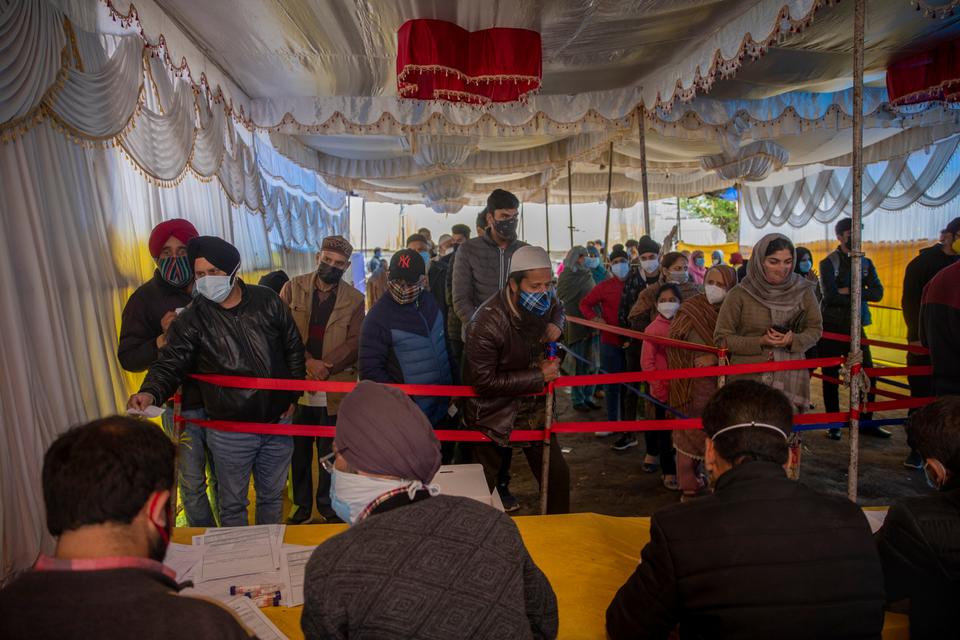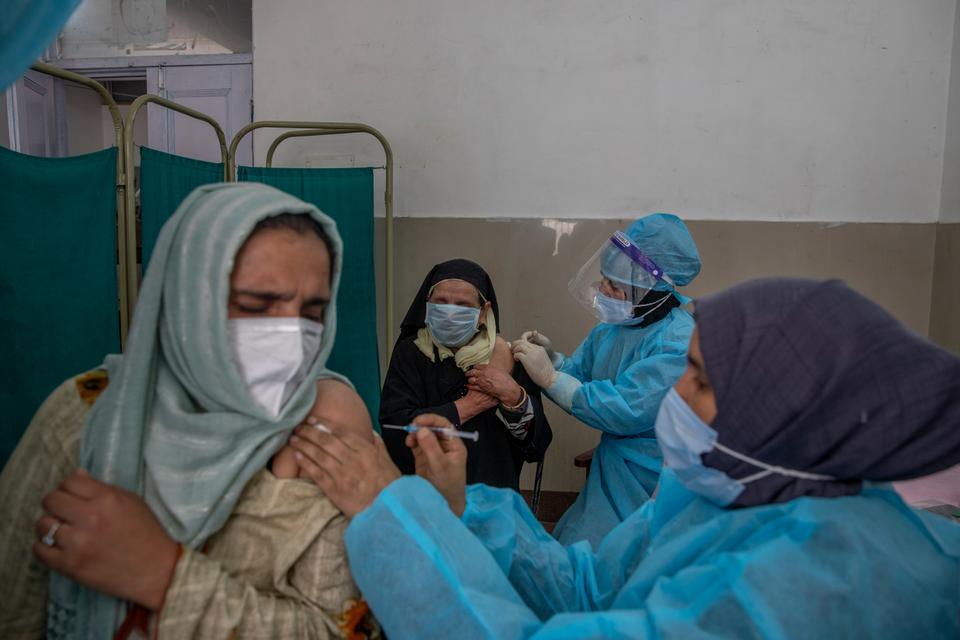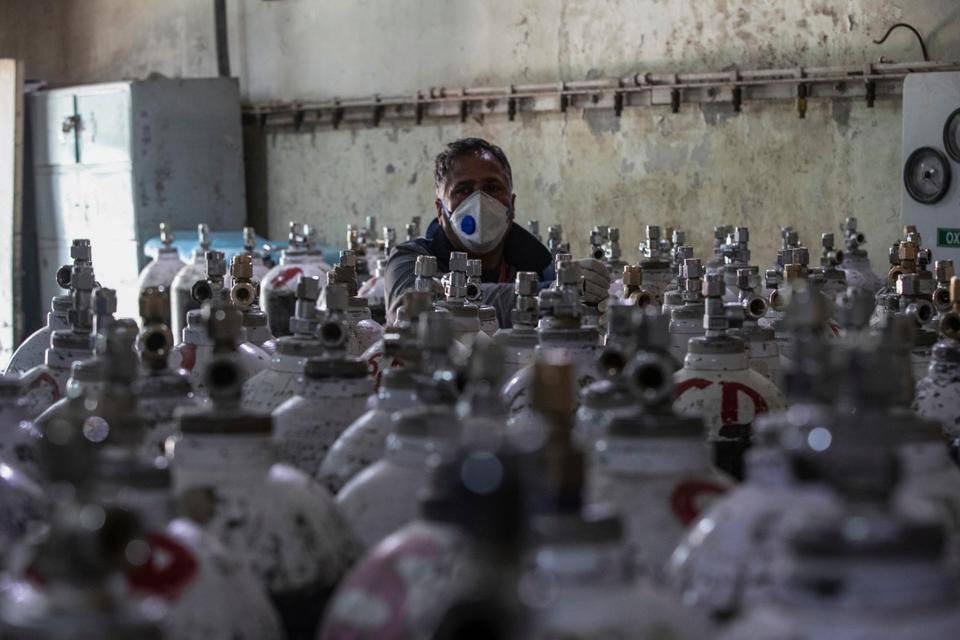The Indian Covid-19 variant has ravaged New Delhi’s health care system. If that variant spreads in Kashmir, its infrastructure is nowhere near prepared to handle such a severe outbreak.
7 May 2021
Srinagar — It was obvious. There were early indications and warnings of an impending second wave of Covid-19 in Indian-administered Kashmir. Even a cursory glance at the daily figures of new cases should have sounded the alarms: the virus had begun to spread rapidly since mid-March — 94 cases on March 15; 140 infections on March 20; 309 on March 28; and then the curve shot up abruptly as if a monster were raising its head. But authorities apathetically continued with festivals and revelry.
On March 24, when Indian Prime Minister Narendra Modi invited people to visit Tulip Garden in Srinagar, Jammu and Kashmir registered 195 new Covid-19 cases, a two-fold increase from the numbers recorded just 10 days before. And 10 days later, on April 4, when Srinagar’s Mayor Junaid Azim Mattu invited people to visit the much-hyped Tulip Garden, located at the foothills of Zabarwan mountain range, the region recorded a spike of 573 new coronavirus cases.
The numbers were not only alarming; they were plainly indicating Kashmir was in the middle of a second Covid-19 wave. Critics and experts rang the alarm bells, but their concerns fell on deaf ears and the administration organised a six-day Tulip Festival to promote tourism, inviting thousands of tourists and locals to see the blooming flowers, attend concerts and other events. On April 8, when the Tulip Festival concluded, Jammu and Kashmir recorded a surge of 835 new Covid-19 cases.
In the name of tourism
Doctors Association Kashmir president and influenza expert, Dr Nisar-ul-Hassan has little doubt as to what’s behind the second wave. “Once we were seeing that it (second wave) was knocking at our door, we should have closed entry, for there were deadlier variants. We should have closed the entry to tourists here,” Nisar tells TRT World.
Nisar says as soon as there were indications of the resurgence of the virus, the administration should have prepared itself, imposed restrictions and expedited the vaccination process. “To be honest, when they closed schools on the one hand, cases were rising outside, there was an influx of tourists, there were variants outside and there was every possibility those variants would sneak in through tourists…they allowed the tourists to come in flocks,” Nisar adds.

On the condition of anonymity, a junior resident posted at Sri Maharaja Hari Singh Hospital (SMHS), Srinagar, and who has been treating Covid-19 patients since last year, tells TRT World that there is a connection between the influx of tourists and the rapid surge in coronavirus cases in the Valley. “When a tourist comes to Kashmir, he meets several people, he goes shopping, visits places…it’s a chain,” the doctor says.
But what stopped the administration from acting on time?
Jammu and Kashmir National Conference leader Syed Ruhullah Mehdi says that it was because of a lack of accountability that made them complacent. When Covid-19 cases started to rise in Kashmir Valley, “they were busy crowding the place to satisfy their need to do PR for their bosses in New Delhi,” Ruhullah says.
After Jammu and Kashmir was downgraded to a federally-controlled territory on August 5, 2019, the Indian government appointed handpicked representatives to run the administration in the region. As of now, in the absence of a locally elected government or representatives, the affairs of government are in the hands of bureaucracy.
Critics of the Indian government and those of the administration in Kashmir say that the ruling dispensation in New Delhi have been busy trying to portray the situation in Kashmir as normal. Syed Ruhullah says that the government of India, led by the Hindu nationalist Narendra Modi, wanted to reinforce that narrative after the August 5, 2019 decision of stripping the region of its quasi-autonomous status.
While the administration says the tourism-related events and festivals in Srinagar in March and April were critical for the resurgence of tourism that provides livelihood to thousands of people, Syed Ruhullah says more than tourism, Kashmir needs peace to thrive.
“It was an orchestrated exercise by the administration to help the government of India,” the National Conference leader and a former minister says.
Ruhullah’s party member, Imran Nabi Dar, who is also party spokesperson, says that it was a tricky situation for the administration to choose between the resurgence of tourism and putting in restrictions. “But the administration should have given priority to human lives,” Imran Nabi says.
He says when the cases were rising in Kashmir and elsewhere, like Maharashtra, “it was a foolish act on their part to have big events and nobody gave a hoot to all the precautions that needed to be taken,” the NC spokesperson says.
The NC leader says the administration should have ensured some basic protocols and precautions if they wanted to let tourism-related activities continue.
Imran Nabi calls it a “blunder” by the administration to let the hundreds of thousands of tourists to visit and says it takes “common sense and not some rocket science” to make the right decisions. “There is an inherent problem in the bureaucratic set-up: they don’t feel accountable to anyone.”
Nisar says the experts had warned well in advance about the second wave. He had predicted – and rightly so – the second wave would be worse. But the only predictable element of this virus is its unpredictability, he says.

Flawed testing
Experts pointed out several flaws in the Jammu and Kashmir administration’s testing strategy at the Srinagar airport. When passengers land at the airport, they undergo a mandatory Covid-19 test after which they are allowed to travel to their destinations. The reports of these tests usually take hours to come and in the case of an RT-PCR test, it takes 24-48 hours to arrive. By that time, a passenger who tests Covid-19 positive has already mixed in with hundreds of people and possibly infected several others.
For the on-arrival testing process, the passengers provide details like flight number, seat number, name, phone number and address. While it is possible to trace Kashmiri residents if they test positive, it is very challenging to trace a tourist who tests positive 2-3 days after their arrival.
In several cases, the tourists who provide their numbers at the time of Covid-19 testing become untraceable as their pre-paid phone numbers, registered outside Kashmir, do not function in the Valley.
Doctors and experts say the administration should have made it mandatory for travellers to get tested before they arrived in Kashmir and carry proof.
This botched Covid-19 testing could have helped the Indian variant of the virus sneak into Kashmir, doctors say, including Dr Nisar.
The junior resident who wished to remain anonymous says that any variant of coronavirus that enters Kashmir comes only from mainland India because that is the only route that connects Kashmir to the rest of the world.
Another doctor, who works at Sher-e-Kashmir Institute of Medical Sciences (SKIMS), Srinagar, echoes the same view. “There are only two routes to enter Kashmir: the airport and Srinagar-Jammu highway. It was easy to contain Covid-19 in Kashmir if these two routes were manned properly,” he says.
Preparedness
As of May 4, the official figures put the total number of Covid-19 positive cases in Jammu and Kashmir at 191,869, of which 152,109 patients have recovered. But doctors and experts say that the real figure is much higher, as a lot of people do not get tested even after they develop symptoms.
The doctor who works at SKIMS says that given the rising number of cases, the availability of beds with ventilators are going to become a major problem in Kashmir. For a population of over 10 million, there are only 359 Covid ICU beds available in Jammu and Kashmir.
Volunteers and several NGOs are working in Kashmir round the clock to attend to SOS calls from Covid-19 positive patients or their attendants. The head of the Social Reforms Organisation (SRO), an NGO that has been answering SOS calls since last year, Mohammad Afaq Syed tells TRT World that the situation in Kashmir has gone out of control as the cases are rising rapidly. He says that oxygen supply is not a problem at this moment in Kashmir, “but we are lacking in capacity building in hospitals. And that cannot be done in a span of one or two weeks.”

In the last 20 days, the SRO has received hundreds and hundreds of SOS calls and they have provided around 600-800 people with oxygen cylinders. Mohammad Afaq says so many SOS calls are directed at them because the administration does not have a system in place where people can access assistance.
As the cases rose dramatically, the administration finally ordered a shutdown of tourist gardens, including Tulip Garden, on April 26. It also imposed a “Corona Curfew” on April 29 in parts of Kashmir that has been extended until May 10.
Jammu and Kashmir’s Lieutenant Governor Manoj Sinha was quoted by several media reports as saying that the region was “equipped to deal with the emerging situation.” He stressed that oxygen availability was more than double the requirement.
The administration has also closed schools and postponed several scheduled examinations. It has been constantly urging clerics to appeal to the public to avoid mass congregations.
Over the next few days, the behaviour of the virus will decide the future course of action by the administration. With experts predicting the peak of the second Covid-19 way in mid-May, several doctors that TRT World spoke to suggest that a lockdown should be immediately imposed to break the chain of the virus, and that period be used to prepare hospitals and vaccinate as many people as possible.
The registration for the annual Hindu pilgrimage, Amarnath Yatra, in Kashmir – that brings hundreds of thousands of pilgrims from different parts of India – has also been suspended temporarily. But the pilgrimage has not been banned as of now.
“The administration should not put the lives of pilgrims and the local population at risk. Holding Amarnath Yatra at this point is very dangerous. I appeal the administration of Jammu and Kashmir to think humanely and take the right decision,” Syed Ruhullah says.
Given how India’s capital Delhi is grappling with the Covid-19 situation, with its health infrastructure almost collapsing in the face of a massive spike in infections, Kashmir needs to be more than prepared to thwart such a disaster. And for that, the administration needs to put its foot down, doctors and critics unequivocally state.
